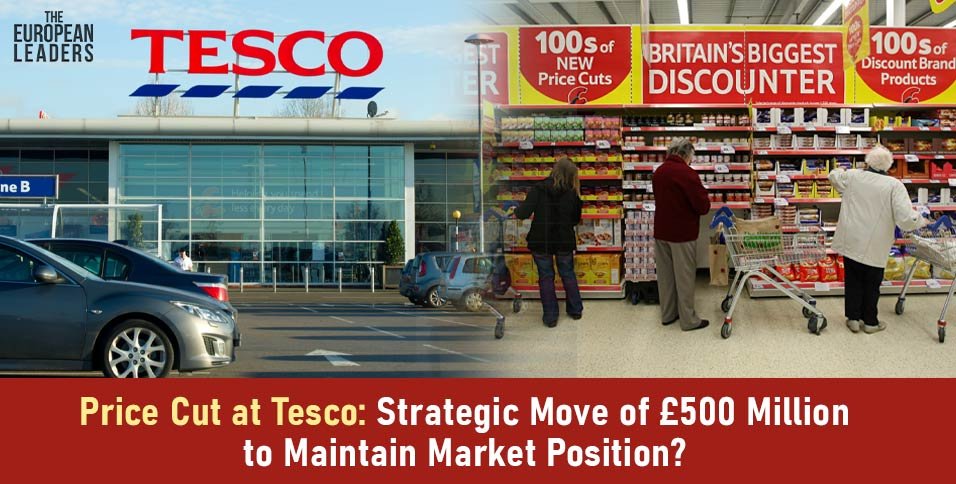The European Leaders
10 April 2025
Welwyn Garden City – In the escalating battle for Britain’s shopping baskets, the Price Cut at Tesco has become more than just a discount—it’s a headline move in a high-stakes strategy.
As competitors such as Asda draw their sabres with sharp price slashes, Tesco, the UK’s largest supermarket chain, has revealed a £500 million cost-cutting drive in a bold attempt to retain its market lead. For shoppers and shareholders alike, this development signals a new chapter in the country’s grocery price war.
A Calculated Shift, Not a Race to the Bottom
Unlike rivals chasing short-term headlines with dramatic shelf markdowns, Tesco’s move is more considered. Rather than slashing prices across the board, the retail giant is investing in operational efficiency, streamlining supply chains and automating back-end processes—to pass value on to consumers without gouging its margins.
The result? A quieter form of warfare one rooted in sustainability and consistency. Tesco’s aim is to offer value that lasts, not just value that shouts. And it may just be the smarter long game.
Balancing Profits and Price Pressure
But this strategy comes with risk. Tesco has revised its profit forecast for 2025/26, now expecting adjusted operating profits between £2.7 billion and £3.0 billion, compared to £3.13 billion the previous year. That drop has unsettled some investors, reflected in a share price dip of over 10% this year.
Still, not all analysts are rushing for the exits. Many see Tesco’s disciplined approach as a stabilising force in an overheated sector.
With a 28.3% market share its strongest since 2016 and annual sales up by 3.5% to £63.6 billion, Tesco’s fundamentals remain robust.
The Asda Effect and Market Reaction
Tesco’s move can’t be separated from Asda’s aggressive pricing, especially in fresh food categories. These bold reductions are Asda’s attempt to claw back market share, but questions loom over whether such deep discounts are sustainable.
This aggressive pricing has sparked a broader sell-off in supermarket stocks. Yet, paradoxically, it may also strengthen Tesco’s hand.
If Asda’s discounts fail to convert into sustained volume growth, Tesco’s steadier strategy could be seen as the wiser path retaining customer trust while keeping the books balanced.
Price Cut at Tesco: Strategy Beyond the Sticker Price!
Beyond the shop floor, Tesco is pulling several levers to cushion the blow of tighter margins. It’s rolling out a “Save to Invest” programme targeting £500 million in annual savings. Automation, supply chain modernisation, and store upgrades form the backbone of this push.
Simultaneously, Tesco is doubling down on its higher-end offerings, with its Finest range seeing a 15% jump in sales.
Add to that a 10.2% rise in online sales boosted by its rapid delivery service Whoosh and you start to see a multi-pronged response designed to protect both revenue and relevance.
And then there’s the loyalty play. With Clubcard usage now at 84% and digital engagement up 12%, Tesco is banking on data and personalised value to keep customers in the fold.
What It Means for Shoppers?
For everyday consumers, the Price Cut at Tesco spells relief amid the cost-of-living crunch. Lower prices—especially in everyday essentials—mean more manageable shopping bills. And with the price war heating up, shoppers can expect more competitive offers across the board.
But there are caveats. Some may worry whether quality might suffer if suppliers are pushed to cut costs. Tesco insists that won’t happen. If it can maintain quality while reducing prices, it will continue to earn consumer trust at a time when every penny counts.
Outlook: Storms, but a Steady Ship?
The pressure is mounting. Discounters like Aldi and Lidl are not standing still, and consumers remain highly price-sensitive. But Tesco’s measured approach—less sword-swinging, more shield-raising—could prove its strength.
Analysts are cautiously optimistic. While short-term turbulence may persist, there’s faith that Tesco’s scale, supply chain muscle, and strategic focus could weather the storm—and maybe even come out stronger.
And with a £1.45 billion share buyback programme and dividend commitments still intact, Tesco is sending a clear message: its fight for the future isn’t just about prices—it’s about staying power.
Bottom Line: The Price Cut at Tesco is more than just a discount; it’s a tactical move in a sector under siege. For shoppers, it means better value. For investors, it’s a waiting game. And for the UK grocery landscape, it marks a strategic pivot that could reshape the market’s competitive playbook.








